Menus
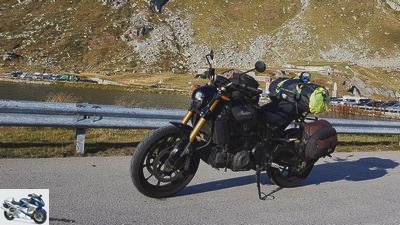
Imre Paulovits
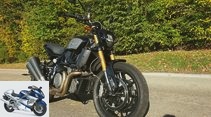
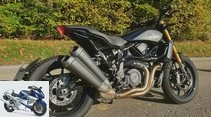

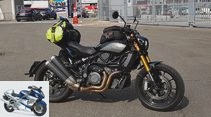
7th photos
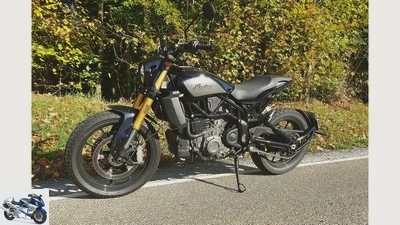
Peter Mayer
1/7
Shortly before the end of the 2019 season, the Indian FTR 1200 is rolling into the MOTORRAD long-term test fleet.

Peter Mayer
2/7
The US-V2 comes as a black basic version.
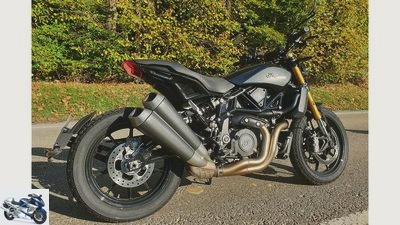
Peter Mayer
3/7
50,000 test kilometers lie ahead of the Indian.
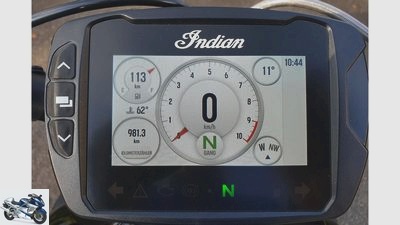
Peter Mayer
4/7
There are currently 981 km on the digital display.
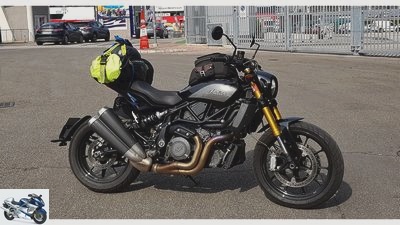
Imre Paulovits
5/7
Visits to the circuit.
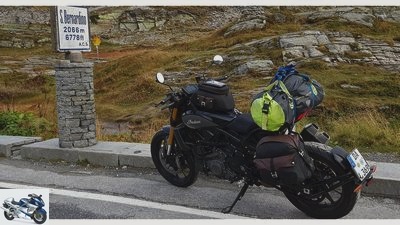
Imre Paulovits
6/7
On the way through the Alps.
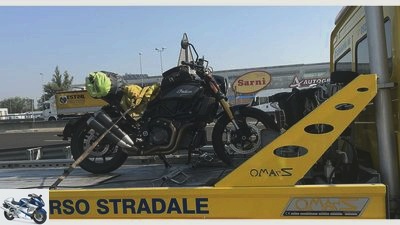
Imre Paulovits
7/7
Fuel shortage in Italy.
Indian FTR 1200 50,000 km endurance test
US-V2 on the marathon distance
The Indian FTR 1200 will take 50,000 kilometers under the wheels in the MOTORRAD endurance test. Here you can read how the US-V2 is doing.
Shortly before the end of the 2019 season, MOTORRAD welcomed a new long-term test candidate to its fleet. The I.The basic version of the ndian FTR 1200 takes on a long-term test in a simple black lacquer dress. At the start of the test, the digital display shows just 980 kilometers.
Peter Mayer
But before the two-cylinder is finally released into everyday editorial work, it has to be measured on the test bench. This is followed by the input measurement as well as the sealing of the motor and a compression measurement. At around 25,000 km, MOTORRAD then publishes an interim endurance test; Final measurements follow after 50,000 kilometers before the Indian’s engine is dismantled and examined.
Mileage: 12,310, 10/2020
Motosport reporter Imre Paulovits made ample use of the Indian for his tours to various races. Here are his remarks: I took over the Indian with the newly assembled cockpit (cockpit swap at 8,820 km), have since driven 3,500 kilometers with her and have been to Misano twice with her, in between in Switzerland.
The tank bag and soft bag were also newly installed. They both look nice, but the gap between the tank bag and the cockpit is so narrow that turning the ignition key is always a finger exercise. The size of the tank pressure bag is ok, I was able to put a rain suit, a spare visor, papers, a drinking bottle and some provisions in it. With a little practice, it can be easily buckled and fastened with its retaining hook for refueling. The pannier also fits a lot, it is easy to put on and take off. But that also applies to thieves, so you shouldn’t leave them on if you let them out of your sight. I couldn’t find out how long they were waterproof, luckily it never rained for long during my two trips to Italy.
Basically, sitting on the Indian is quite comfortable, the mobile travel speed is just like a naked bike, around 140 km / h. But you can’t drive faster outside of Germany anyway. Once you have come to terms with the clutch, which takes a bit of getting used to, the engine is basically a pleasant companion and above all situations on the motorway.
On the country road, however, comes great disillusionment. The electronics engineers should have spent less time programming the mouse cinema with different viewing modes and more with mapping. If you turn on the gas after coasting, she hiccups all the time, and the higher you get above sea level, the worse it gets. The hairpin bends on the wet road up the San Bernadino were a real torture, where I had to drive like a racing two-stroke: always with one hand on the clutch to take out the torque peaks when suddenly using power. Otherwise there would have been a high risk of the rear wheel breaking off.
Imre Paulovits
The chassis is quite comfortable for me. She doesn’t like very tight, but with the wheelbase it is understandable. For 19 inches at the front and 18 inches at the rear, the handiness is quite good. The brakes are very good, and the spring elements showed real potential on the undulating surface of the Alpine passes. Where sporty naked bikes and athletes jump over the many short waves in succession, the FTR’s wheels stay on the ground like a travel enduro, but it is vastly superior to those in fast corners and when braking. The ground clearance until the pins touch down in the footrests is exactly sufficient for the grip limit of the tires.
The Indian’s consumption is around six liters, but its twelve-liter tank is not exactly what you want to travel with. The last two liters can only be filled with difficulty. In Italy I once got into the uncomfortable situation that the fuel gauge showed 64 kilometers, then suddenly reserve, and finally I was four kilometers from the next gas station. Not pleasant when the police come.
Imre Paulovits
With the next tank of fuel, it showed a range of 192 kilometers, but I knew that this couldn’t be. Then it was 140 kilometers, 90 kilometers, suddenly what was in reserve again, and when I refueled five kilometers later, the tank was almost empty. After that this phenomenon did not occur again.
I noticed the LED headlight positively. The light is bright and illuminates the roadway with both the low beam and high beam without spots.
Mileage: 3,729, 3/2020
Nice machine. It’s much more delicate than the motorcycles I have in mind when I think of an Indian. Still, the wide bench ensures that I need a few kilometers to feel reasonably safe in stop-and-go traffic and at red lights. With my height of 1.58 meters, I can tip my toes down on one side, but I have to decide which side to use in good time and accordingly to the right or left on the bench "offset".
Ferdinand Heinrich
Nice piece, the Indian FTR 1200. Unfortunately, the seat is a bit wide, so drivers with 76 cm inner leg length – and less – only "one-legged" get on the ground.
Before I start, however, I am confronted with the question: Why doesn’t it start?? "You have to put it into neutral first, then it’s okay." Although the side stand is not unfolded. So so. American logic? No idea.
Sitting position: With my short arms I did not expect a lean-back posture, but that the footrests are positioned so far back, the handlebars are quite wide and the upper body is clearly oriented towards the front wheel, I am positively surprised. The engine delivers a lot of power, I didn‘t feel anything from an immature mapping. On the other hand, I felt quite a lot in the soles of my feet – namely, vibrations that the footrests transmit. Fortunately, the same doesn’t apply to the handlebars and handles.
Mileage: 515, 10/2019
Peter Mayer
After the run-in period was completed, the obligatory input measurement was carried out on the test bench. And lo and behold: all the promised horses have come to service and even two more in reserve. The factory specification is exactly met for the torque. The first entries in the logbook make you sit up and take notice. On the one hand, the engine earns great praise for its bearish thrust, but its overall behavior leads some drivers to the conclusion that not all program lines have been written when mapping, so the comparison to older MV-Agusta models fell. We are excited to see what the time brings and will report on it.
Related articles
-
Endurance test of the BMW K 1200 RS Big hum happy ending for the BMW K 1200 RS: After engine failure, the high-torque four-cylinder reeled the …
-
Endurance test Ducati Multistrada 950 2017
Jacek Bilski 34 pictures Jacek Bilski 1/34 The Ducati Multistrada 950 has passed the MOTORRAD endurance test over 50,000 kilometers since May 2017. Hertler …
-
Endurance test BMW K 1200 RS (engine damage)
Endurance test BMW K 1200 RS (engine failure) A Munich in heaven rejoicing was announced. The deputy test department head of MOTORRAD and Ur-Bayer …
-
BMW R 1200 GS endurance test final balance
Bilski 33 photos BILLION 1/33 The rating table gives an overview of the MOTORRAD endurance test machines from recent years. A maximum of 100 points can…
-
Endurance test interim balance of the BMW R 1200 GS
Photo: www. 34 photos fact 1/34 Gerhard Eirich, MOTORRAD Classic: “There really only remains to be said: Hats off”. 2/34 artist 3/34 with a crashing …
-
Endurance test interim balance of Ducati
Lons 18 pictures Lons 1/18 Ducati Head of Marketing Diego Sgorbati, … Lons 2/18 At least one new model name GT 1000 Touring. Lons 3/18 Lons 4/18 …
-
Endurance test final balance Yamaha XT 660 X
Bilski endurance test final balance of the Yamaha XT 660 X The tent travelers Thirty years after their debut, the youngest generation of the Japanese …
-
KTM 1190 Adventure in 50,000 km endurance test
markus-jahn.com 45 pictures KTM 1/45 January 2013: Already at the presentation it is clear – the new KTM is a great success. markus-jahn.com 2/45 July 2013: …
-
BMW S 1000 RR (2019) in the 50,000 km endurance test
Topic special Everything about BMW Motorrad Tobias Wassermann. 7 pictures Uli Baumann 1/7 MOTORRAD welcomes the BMW S 1000 RR to the long-term test fleet. Uli Baumann …
-
Endurance test BMW R 1200 GS gearbox damage
mps photo studio 10 pictures Alschner 1/10 mps photo studio 2/10 mps photo studio 3/10 BMW / Motociclismo 4/10 The replacement of the entire fuselage engine was the …